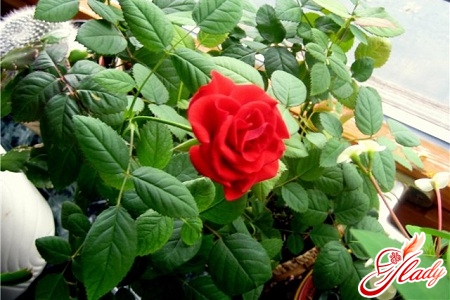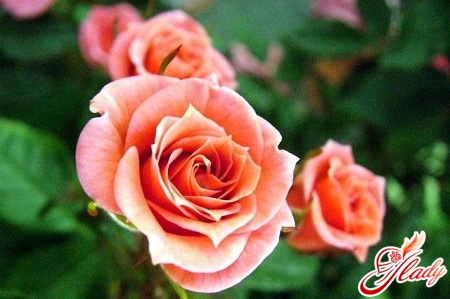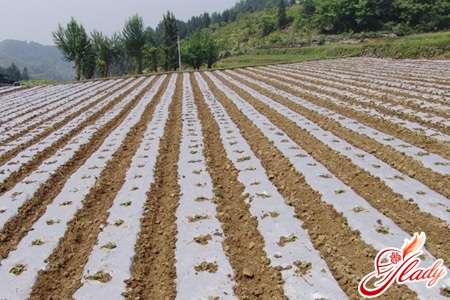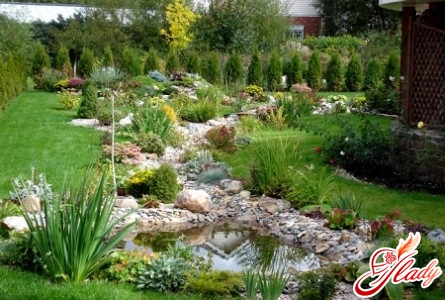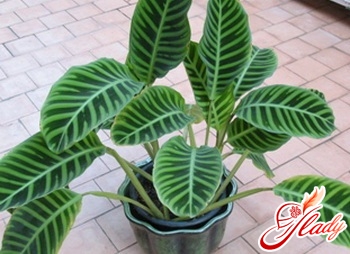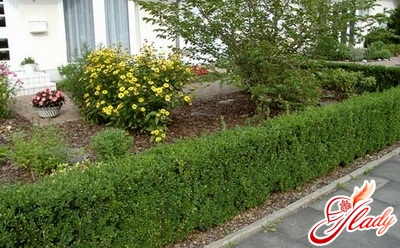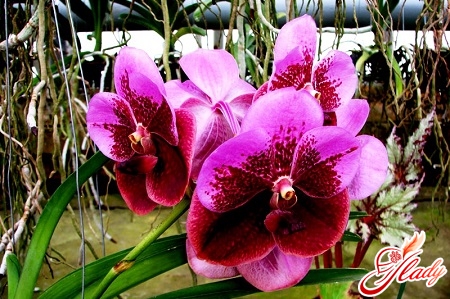 Lovers grow indoor plants notBright and beautiful orchids can bypass their attention. But the presence of Phalaenopsis on the windowsill is hardly anyone you can surprise. But an exotic beauty with a sonorous woman's name Wanda is still found in domestic florists is not so often. Experts call this orchid queen among other representatives of its kind. Indeed, this plant has buds of stunning brightness and beauty. The blue orchid from this worthy aristocratic family was especially fond of the flower growers, because it has an unusually rich and at the same time deep shade from soft blue to purple. Such a sonorous name of the plant is in no way connected with the female name, although many people think so. The word "Vanda" in Sanskrit Indians called orchids, leaves and stems that were used as raw materials for the preparation of medicinal potions. This genus includes about fifty different species. There are among them both growing on the trees epiphytes, and lovers of rocks - lithophytes. Since humanity has a desire to surround itself with blooming beauty, then through the cultivation and crossing of various representatives of the vandas, very effective hybrids have turned out, quite suitable for breeding and growing at home, although they need special care. To date, there are about forty species. And now botanists were puzzled by the withdrawal of miniature representatives of these plants. In the natural environment, the orchid vanda often occurs in countries with a tropical climate, namely Indonesia, India, China, Australia and the Philippines. Most of the representatives of the genus Vandus are fairly tall (up to one meter) shoots with long, belt-like leaves. Surprisingly interesting location of large bright buds of the plant. They are formed in practically the same plane, and as a result, the inflorescence has the shape of a sphere. Rounded at the ends of petals of some vandas exude a delicate sweetish aroma. As for their coloring, it is both monotonous deep shades, and their various combinations. Special attention should be paid to the root system, which is possessed by the orchid of the genus Vand. It does not form pseudobulbs, as do its other relatives for the accumulation of nutrients. In return, we can see sprouting of comparatively thick air roots covered with a layer of velaman. This is a fairly effective protection of the tender internal parts from sunburn and a kind of sponge that absorbs moisture even from the environment. That is why vandas are usually grown either without or in the substrate, but with a powerful drainage system. They are suspended in special flat baskets or vases, since the root system of plants requires a constant supply of fresh air and light.
Lovers grow indoor plants notBright and beautiful orchids can bypass their attention. But the presence of Phalaenopsis on the windowsill is hardly anyone you can surprise. But an exotic beauty with a sonorous woman's name Wanda is still found in domestic florists is not so often. Experts call this orchid queen among other representatives of its kind. Indeed, this plant has buds of stunning brightness and beauty. The blue orchid from this worthy aristocratic family was especially fond of the flower growers, because it has an unusually rich and at the same time deep shade from soft blue to purple. Such a sonorous name of the plant is in no way connected with the female name, although many people think so. The word "Vanda" in Sanskrit Indians called orchids, leaves and stems that were used as raw materials for the preparation of medicinal potions. This genus includes about fifty different species. There are among them both growing on the trees epiphytes, and lovers of rocks - lithophytes. Since humanity has a desire to surround itself with blooming beauty, then through the cultivation and crossing of various representatives of the vandas, very effective hybrids have turned out, quite suitable for breeding and growing at home, although they need special care. To date, there are about forty species. And now botanists were puzzled by the withdrawal of miniature representatives of these plants. In the natural environment, the orchid vanda often occurs in countries with a tropical climate, namely Indonesia, India, China, Australia and the Philippines. Most of the representatives of the genus Vandus are fairly tall (up to one meter) shoots with long, belt-like leaves. Surprisingly interesting location of large bright buds of the plant. They are formed in practically the same plane, and as a result, the inflorescence has the shape of a sphere. Rounded at the ends of petals of some vandas exude a delicate sweetish aroma. As for their coloring, it is both monotonous deep shades, and their various combinations. Special attention should be paid to the root system, which is possessed by the orchid of the genus Vand. It does not form pseudobulbs, as do its other relatives for the accumulation of nutrients. In return, we can see sprouting of comparatively thick air roots covered with a layer of velaman. This is a fairly effective protection of the tender internal parts from sunburn and a kind of sponge that absorbs moisture even from the environment. That is why vandas are usually grown either without or in the substrate, but with a powerful drainage system. They are suspended in special flat baskets or vases, since the root system of plants requires a constant supply of fresh air and light.
The main representatives of the family of vandas
As mentioned above, the queen of the familyvand is considered a blue orchid. For the first time experts knew about its existence in 1837, when they studied the foothills of the eastern part of the great Himalayas. It was there that this extraordinary flower was noticed, majestically adorned with crowns of mighty trees. Wanda Blue is a fairly tall plant (about ninety centimeters) with a developed system of air roots. Its leaves are dark green and long with a characteristic glossy sheen. Buds have a mesh pattern on rounded petals and are painted in a juicy lavender or even darker shade. On one pedicel, there are usually up to twelve of them. Interestingly, the color of the petals over time tends to change the original saturated color to a pale blue. It is impossible not to mention the bright beauty of a three-colored wanda. This plant can reach from one and a half to two meters in height. Its strap-like leaves up to forty centimeters grow in two rows, and the buds in the blossom form seven centimeters in diameter, forming large inflorescences from such giants. Incidentally, it is the three-colored vandal petals that have a strong aroma, they are slightly wavy along the edges and have a delicate cream color with brownish spots. Among the indoor orchids, you can find a vandalized wanda. This epiphyte differs from its tribesmen in a long and very branched crochet stalk (sometimes up to two and a half meters) with numerous air roots. On one leg is located three to six flowers, which can reach about ten centimeters in diameter. Their shade varies from gentle pink to slightly reddish. The petals have an oval, rhomboid or round shape, they are wavy along the edges. Another large orchid of this genus is Wanda Sander. Its stem in length can sometimes reach one meter. On it there are forty-centimeters narrow leaves and apex inflorescences, consisting of buds (up to ten pieces) with pink petals and a white border. The diameter of the flowers is about twelve centimeters. In the natural environment, this plant blossoms in the autumn, and in the home, if you look after it correctly, in the spring. Wanda blue and sander as a result of crossing gave one more variety - the vandal of the Rothschild. Its height is in the range of sixty to ninety centimeters. Leaflets, like most representatives of the family, resemble belts. On the pedicel develops up to six buds, the diameter of which is four centimeters. Light blue petals have a regular round shape. The plant blooms twice a year - in summer and in winter. 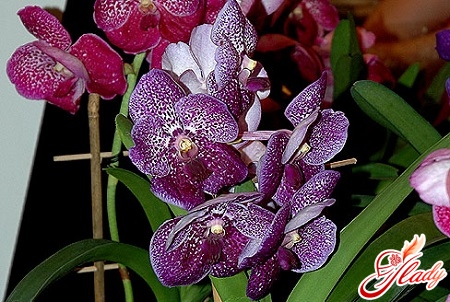
Features of care for the vanda
Orchid Vanda is a real tropical beauty withcapricious character. Unlike the rather unpretentious Phalaenopsis, it requires much more attention, and caring for it is not so simple for a beginner. First of all, you need to take care of the proper location of the plant. Wanda needs a lot of sunlight and fresh air. To do this, your orchid is best to "settle" on the windows facing south-east, south and south-west. On hot days, when the sun's rays are especially ruthless, the plant needs to create a shadow, otherwise burns are provided. The light day for any vand should be at least twelve to fifteen hours. Therefore, be prepared for the fact that in the autumn and in winter you will have to provide the plant with an additional source of artificial lighting. If this is not done, then the orchid will not bloom in due time. Since the plant came to us from the tropics, it is very important for him to create and maintain certain conditions. The optimum temperature for a vand is the range from twenty to twenty-five degrees Celsius, the winter minimum should not fall below fourteen. For the flowering of this orchid, the temperature jumps are destructive, but small night drops within eight to ten degrees, on the contrary, are useful. This has a favorable effect on the regularity of flowering. Tropical conditions of origin of vandas have led to the fact that today plants need a high humidity environment. Therefore, to ensure proper care, you will probably have to purchase an air humidifier, because when the heating season begins, you can not do without it. The optimum humidity level for vandas is from sixty to seventy percent. Therefore, if you are faced with a problem in which the orchid flowers, not yet fully opened, are already wilting and fall off, and the leaves and air roots dry out, pay attention to the humidity in the room. Aquarium, decorative fountains and pallets with gravel will help reduce the dryness by several percent. But remember that high humidity requires good air circulation, otherwise plant diseases are likely. But the cold winter, when the temperature in the room is limited to a mark of fourteen degrees Celsius, on the contrary, provides for the presence of more dry air. But this is more a recommendation for greenhouses, because such conditions for living spaces are difficult to imagine. Since many vandas do not have a rest period, they need year-round care. They will have to be watered constantly and moisten the substrate in time. In the hot summer it is recommended to irrigate the leaves of the orchids several times a day with a spray gun. But do not forget that the roots between watering should dry up, because the dampness is quite dangerous for these plants. If you prefer to grow vandas without a substrate, as often recommended by experienced growers, then make them a bath with warm water as the roots lighten: minimum - twice a week, a maximum - every day. You can ask a completely reasonable question - why is it better to contain vandas without a substrate? The fact is that it's easier to take care of them. This growing system gives all the possibilities to properly assess the condition of the roots of the plant in order to provide it with the necessary watering. After all, the upper part can say that it's time to give them water, but the one below is still wet. This creates a favorable environment for the emergence of various rot of the root system, and this is the most common reason for the disease of orchids. By the way, with decreasing temperatures, care for them also changes: the intervals between watering or baths increase. 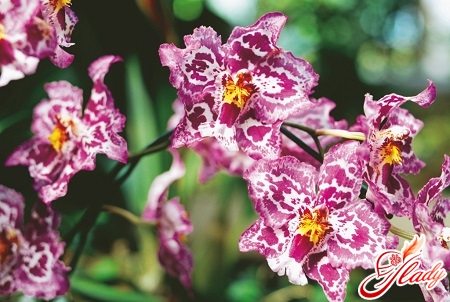
Fertilizing, pruning, reproduction, orchid transplantation
If your window has a vanda-tropikanka, thenyou can not do without a lot of special fertilizers for orchids. During active growth, you need to feed the plant at least once a week, and in winter it is necessary to do it once a month. You can root and root system, and leaves. It is important only to adhere to the norms specified in the instructions for the selected drug. You can not exceed or understate them. In the first case, flowering is not possible in full force, and in the second one, it is impossible to avoid such changes in the stem as its excessive fineness and elongation, and the tip can be bent due to unnatural softening. Since many vandas are quite long, sometimes there is a need for trimming. It is recommended to carry out and in the event that the plant has lost part of the lower leaves and therefore does not look very aesthetic. You will simply have to cut off the upper part of the orchid, making two orchids out of one. But first, decide whether the half intended for the branch has healthy roots in the number of three to four pieces. If they are available, then boldly cut it and transplant it as a separate copy. Do not forget to sprinkle fresh slices of coal or cinnamon - they will play the role of a kind of antiseptic. The rest of the orchid is not thrown away, but continue to care for it according to the previous algorithm. Then over time, she will release a new shoot-baby, either at its base or at the top. As for transplanting vandas, it is carried out in the spring, having previously estimated the condition of the substrate and the roots of the plant. Reproduction of representatives of this family is carried out with the help of cuttings. For this, the upper parts of the lateral shoots, already having air roots, are taken. In order to obtain the largest possible material for breeding, the mother plant needs to remove the tip of the kidney. It is this condition that contributes to the numerous growth of the lateral stems, which in a year are excellent cuttings, which make it possible to reproduce. These processes should be separately placed in vases filled with a special substrate consisting of the roots of the fern and moss-sphagnum. It is necessary to provide for good drainage. The first three for planting cuttings are not watered, and then the substrate should be slightly moistened within one to two months. As soon as the active growth of young orchids begins, we can conclude that the reproduction was successful, and it is time to take care of them according to the usual algorithm. It remains to say a few words about pests that can cause significant damage to your collection of blossoming tropical beauties. Fortunately, vandas with dense fleshy leaves are rarely attacked by parasites. However, weakened plants can become a tasty morsel for the mealybug and scab. To ensure that these pests have not been able to firmly settle on the plant and have been noticed in time, you should regularly inspect their orchids. If, nevertheless, you have discovered the presence of parasites, then, using a cotton swab and soap or alcohol solution, immediately remove them from the leaves and stem of the affected plant. A severe infection will require spraying with a corneum or carbophos. In principle, the cultivation of orchids and care for her at home is not particularly difficult, although it is quite laborious. Therefore, do not buy these exotic plants, if you are attracted only by their external beauty, and not love for all, without exception, representatives of the home flora. To the orchids pleased with their flowers and served as an excellent complement to the interior, they will require from you a daily attention and a caring attitude. Therefore, weigh all the pros and cons and only then buy the liked tropical beauty. We advise you to read:




